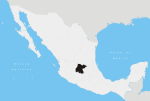Guanajuato, Guanajuato
| Historic Town of Guanajuato and Adjacent Mines* | |
|---|---|
| UNESCO World Heritage Site | |
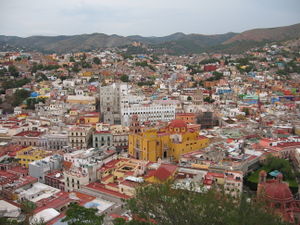 |
|
| State Party | |
| Type | Cultural |
| Criteria | I, II, IV, VI |
| Reference | 482 |
| Region** | Latin America and the Caribbean |
| Inscription history | |
| Inscription | 1988 (12th Session) |
| * Name as inscribed on World Heritage List. ** Region as classified by UNESCO. |
|
The Mexican city of Guanajuato is the capital of the state of the same name. It is located 370 km (230 miles) northwest of Mexico City, at an elevation of 1,996 m (6,550 ft) above sea level. The historic town and adjacent mines are a World Heritage Site. Much of the car traffic in the city uses an underground road network.
Guanajuato, although it is the state capital, is only the fifth-largest city in the state, behind León, Irapuato, Celaya, and Salamanca. The 2005 census population was 70,798 people in the city. Guanajuato is also the name of the surrounding municipality of which the city is the municipal seat. The municipality had a population of 153,364 and an areal extent of 996.74 km² (384.84 sq mi). The city of Guanajuato lies near the western edge of the municipality, which includes numerous smaller outlying communities, the largest of which are Marfil, Yerbabuena, and Santa Teresa.
Contents |
History
Guanajuato was founded as a town in 1554 and received the designation as a city in 1741. It is located in one of the richest silver mining areas of Mexico, and is well known for its wealth of fine colonial era Spanish architecture.

The Spanish name "Guanajuato" comes from Quanaxhuato (or Kuanasiutu in a different orthography), meaning "Hill of Frogs" in P'urhépecha (a large rock formation outside of the city of Guanajuato looks remarkably like a frog, and frogs are common in the region).[1][2] In the native religion, the frog represented the god of wisdom.
The city was originally built over the Guanajuato River, which flowed through tunnels underneath the city. However, after years of raising buildings to accommodate repeated flooding, in the mid-twentieth century, engineers built a dam and redirected the river into underground caverns. The tunnels were lit and paved with cobblestones for automobile traffic, and this underground road network carries the majority of cars driving through the city today. It is one of the most notable features of the city.
The city played a major role in the Mexican War of Independence since it is the capital of the state of Guanajuato in which Miguel Hidalgo started the independence movement. The statue of El Pípila and the Alhóndiga de Granaditas still remind of that time.
Climate
| Guanajuato | ||||||||||||||||||||||||||||||||||||||||||||||||||||||||||||
|---|---|---|---|---|---|---|---|---|---|---|---|---|---|---|---|---|---|---|---|---|---|---|---|---|---|---|---|---|---|---|---|---|---|---|---|---|---|---|---|---|---|---|---|---|---|---|---|---|---|---|---|---|---|---|---|---|---|---|---|---|
| Climate chart () | ||||||||||||||||||||||||||||||||||||||||||||||||||||||||||||
|
||||||||||||||||||||||||||||||||||||||||||||||||||||||||||||
|
||||||||||||||||||||||||||||||||||||||||||||||||||||||||||||
For an explanation of Guanajuato's climate, see the chart to the left.
Attractions

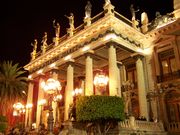
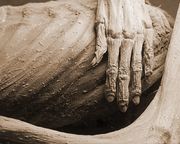
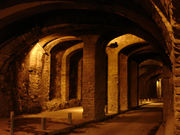
Cristo Rey del Cubilete (Christ the King Shrine) is one of Mexico's most important religious monuments, and is said to mark the geographic center of Mexico.[3] The 65-foot statue atop Cerro del Cubilete is the destination of an annual cabalgata (pilgrimage) every January to celebrate the Epiphany, in which thousands of pilgrims, mostly on horseback, ride to the shrine.[4]
In the Panteón catacombs to the west of the city is a famous cemetery noted for the natural mummies produced by unknown means. About 1 in 100 bodies buried here experienced natural mummification. In the late 1800s the town instituted a "burial tax" for the families of the deceased. When some of the poorest families were unable to pay the tax, their relatives were dug up and placed on public view in a purpose-built museum. The museum holds 111 corpses resting on velvet pillows. Today, it is reported that the proceeds from the museum help fund the city's coffers to a considerable degree.
The city of Guanajuato was the birthplace of artist Diego Rivera, whose house is now a museum.
The city also harbours one of the largest places in Mexico for mathematical research, a public institution dubbed CIMAT.
During the final week of July, Guanajuato and San Miguel de Allende are co-hosts to the Expresión en Corto International Film Festival, Mexico’s largest competitive film festival and the most prestigious of its kind in Latin America. The internationally renowned festival is free to the public and screens over 400 films from 10am until 4am each day in 16 venues, which include such unusual locations as the subterranean streets and tunnels of Guanajuato, the Guanajuato Mummy Museum and Municipal graveyard (Panteónes).
Each October the city holds the Festival Internacional Cervantino, an international festival of the arts named after Miguel de Cervantes. The festival is a popular draw for young students from across central Mexico, but attracts participants and spectators from around the world.
The Festival Medieval Guanajuato is another important attraction.
Sister cities
Guanajuato has 16 sister cities and friendship agreements with 2 cities:[5]
Friendship cities |
Gallery

 University of Guanajuato |
 Local Hero, El Pípila |
 Teatro Juarez |
 Plaza de la Paz |
 Panoramic view of downtown from atop the Pípila monument |
 Alhóndiga de Granaditas |
 City surroundings |
 Street tunnel |
Notable natives and residents
- Jorge Negrete, Famous Mexican singer from the "Golden Age" of Mexican cinema.
- Diego Rivera, Mexican Muralist.
- Juan José Arreola, Poet and Writer.
- Alfredo Dugès, Mexican naturalist.
- Emma, Godoy, Academic and Writer.[6]
- Jorge Ibargüengoitia, Journalist and Writer.
- Enrique Ruelas, Poet, Writer and Director of the Theater of the University of Guanajuato. .[7]
Notes
- ↑ Ramirez Mora, Jorge Alberto (date unspecified, ca. 2005). ¡Así es! Guanajuato... Patrimonio de la Humanidad. Guanajuato, GTO, Mexico: RG Digital. no ISBN number.
- ↑ editorial staff (date unspecified, ca. 2005). Guanajuato Mexico. Guanajuato, GTO, Mexico: Editoriál Stampart. no ISBN number.
- ↑ Cristo Rey Shrine. Guanajuato capital
- ↑ Fuller, Alexandra (August, 2007). "Mexico's Pilgrim Cowboys". National Geographic: 130–139.
- ↑ "Guanajuato's Sister Cities". Honorable City Council of Guanajuato. 2009. http://www.guanajuatocapital.gob.mx/ciudadeshermanas/ingindex.html.
- ↑ Godoy, Emma (Spanish) Cuentos del mundo
- ↑ World Encyclopedia of Contemporary Theatre: The Americas
References
- Link to tables of population data from Census of 2005 INEGI: Instituto Nacional de Estadística, Geografía e Informática
- Guanajuato Enciclopedia de los Municipios de México
External links
- (Spanish) Municipio de Guanajuato Capital Official website
- The City Of Guanajuato by Doreen Stevens, Our Mexico
- Photo Essay of Valenciana Church of San Cayetano and environs in Guanajuato
- High resolution photographs and discussion in English
|
|||||||||||||||||||||||||||||
|
|||||
|
|||||||||||
